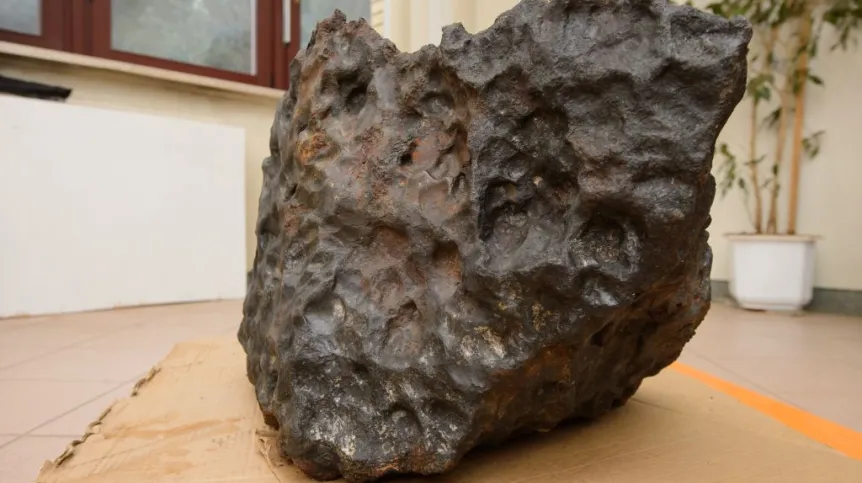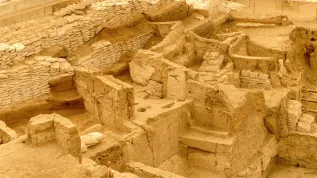
A hundred years ago, during the construction of a military fortification, German naturalist accidentally discovered a meteorite near Poznań. After decades of research, it turned out that it was a part of meteor shower that fell in the area of today’s Poland approx. 5 thousand years ago.
The iron block found on 12 November 1914 in the northern part of Poznań weighed approx. 80 kg. Since then, in the vicinity of Poznań – Morasko, nearly 1.5 thousand fragments of the iron meteorite have been found, with a total weight of approx. 2 tons. In this area, explorers also found two of the largest meteorites in Poland: "Rudy" and "MeMorSS".
"Morasko is famous for the largest iron meteor shower in Europe. The meteorite probably originates from the asteroid belt between Mars and Jupiter. We have drawn the ellipsoid of its spreading and we know that it came from the northeast" - told the PAP Prof. Andrzej Muszyński, geologist from Adam Mickiewicz University in Poznań.
Meteorite researcher added that such events are extremely violent and catastrophic; the fall takes 3-5 seconds, and craters are formed in one second.
In the northern part of Poznań there are seven funnel depressions in the ground, which periodically fill with water; the largest has a diameter of 100 m. In the course of many years of research, scientists were able to determine that they had been created by the fall of a meteorite. Meteorite Reserve was established in this area.
Prof. Muszyński explained that at the bottom of impact craters there were no meteorite fragments. "Just like there are no bombs in bomb craters. Falling meteorite was torn apart in the air a few times, was pushing a very dense cushion of air, and along with this energy stuck in the ground. Produced plasma acted as an explosive" - described the scientist.
As a result of the meteorite fall, in the area of today’s northern part of Poznań there was an earthquake and a great fire; the entire local ecosystem has changed.
Intensive scientific study of both the history of the fall, as well as the meteorite itself has continued for the past half-century. Morasko was also the subject of one of the episodes of "Meteorite Men" broadcast by Discovery Channel - during their stay in Poznań Geoffrey Notkin and Steve Arnold found a fragment weighing approx. 30 kg.
MeMorSS, Poland\'s largest and Europe’s fourth largest meteorite, was found in Morasko only two years ago. It weighs 261 kg. According to Prof. Muszyński, the discovery was made possible by modern equipment and skills of the hunters.
The name MeMorSS comes from the abbreviation of Morasko Meteorite, and double "S" in the name are the first letters of the names of its discoverers: Magdalena Skirzewska and Łukasz Smuła.
The first fragment of Morasko meteorite was found by accident. During World War I, German naturalist drafted to the army took part in digging trenches near what was then the village of Morasko. The find was sent to Berlin, where the naturalist’s assumptions were confirmed.
Prof. Muszyński told PAP that the fragment found one hundred years ago returned to Poznań in the early 1950s, but not for long. "A few years later, large exhibition of Polish collections of meteorites was held in Warsaw. Similar exhibitions were organised in Chorzów and the +comrades+ finally decided that Krakow would be a good place for the fragment" - the researcher explained.
On the occasion of the 100th anniversary of the discovery of the first fragment of the meteorite, popular science conference was organized in Poznan at the Faculty of Geography and Geology, Adam Mickiewicz University. The faculty building is located near the Meteorite Reserve, and it houses the Museum of the Earth is where visitors can see the largest collection of meteorites in Wielkopolska, including Rudy and MeMorSS.
Morasko Meteorite Reserve on the slopes of Mount Moraska documents the site place the largest iron meteorite shower in Europe. It is also one of the few known places in the world where both meteorites and impact craters caused by the fall are found next to each other.
PAP - Science and Scholarship in Poland
pil/ cza/ mrt/
tr. RL













